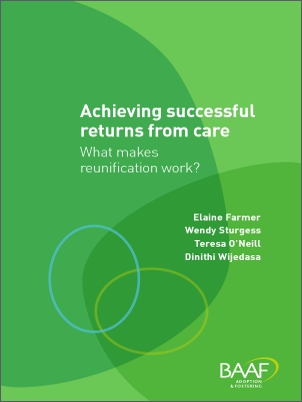
Achieving successful returns from care eBook only
Reunification has been little studied in the UK but given its place in care planning for looked after children, it deserves greater attention. There is a real need for up-to-date information to enable local authorities to make informed decisions about when to return children to their parents, and what services and case management will increase the chances of success. This important study focuses on 180 children, aged 0-14, who were all returned home from care in six local authorities in England.
It follows the patterns and outcomes of return home; which factors are associated with successful and unsuccessful returns; and the families' views on returns. The study’s results provide important conclusions for policy and practice.
This book is valuable for all social workers and managers involved in planning or implementing returns home for children in care, along with policymakers in the field.
This book is available as an eBook only. It can be downloaded free by CoramBAAF members from the members’ area of the website or purchased below.
Questions about eBooks? Check out our FAQs
HARD COPY
Sorry, but this book is currently out of stock.
Reviews
The researchers’ analysis and qualitative discussion of the various children and their families is relevant to practitioners, however worthy to note that the style of the book is such that there is much statistical analysis and commentary on methodology…[Chapters 1 and 2] may be overly detailed for busy practitioners, particularly those without a background in research methodology…The overall message of the research is relevant for all practitioners working with children and families and for practitioners who work with children looked after or children who may become looked after. For practitioners, the research has implications for the planning and support offered to children returning to their family’s care.
Ceri Owens, Social Worker, Child Protection, North West England, Child & Family Social Care
